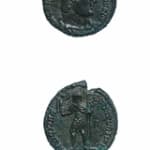Bronze Centenionalis of Emperor Magnentius, 350 CE - 353 CE
Bronze
C.7025
Further images
Obverse: IMP CAE MAGNENTIVS AVG; Draped and Cuirassed Bust of the Emperor Facing Righ Reverse: FELICITAS REIPVBLICE; Magnentius Standing to the Left, Holding Victory and a Military Standar Flavius Magnus...
Obverse: IMP CAE MAGNENTIVS AVG; Draped and Cuirassed Bust of the Emperor Facing Righ
Reverse: FELICITAS REIPVBLICE; Magnentius Standing to the Left, Holding Victory and a Military Standar
Flavius Magnus Magnentius was born in 303 A.D. to barbarian parents, his mother was Frankish and his father was British. He rose through the ranks of the military until he became one of the top generals serving under Constans, Emperor of the West. In 350 A.D., Magnentius led a rebellion against Constans who fled from Magnentius’ superior forces and was eventually murdered. Subsequently, Magnentius declared himself Emperor of the Western Roman Empire. However, ambition would overcome Magnentius when, not satisfied with his new status, he attacked Constantine II, Emperor of the East, in a bid to secure the entire Roman Empire under his power. After some early successes, Magnentius was dealt a humiliating defeat in 351 A.D. at the Battle of Marsa. Magnentius retreated to Gaul but Constantine’s forces followed him and slowly whittled away at his support until finally, in 353 A.D., his soldiers abandoned him and Magnentius committed suicide. Magnentius made extensive use of Christian imagery on his coinage (even though he himself was pagan) in order to mobilize the will of the people to his side, revealing just how prominent Christianity had already become in the political sphere of the Empire.
How many hands have touched a coin in your pocket or purse? What eras and lands have the coin traversed on its journey into our possession? As we reach into our pockets to pull out some change, we rarely hesitate to think of who might have touched the coin before us, or where the coin will venture to after it leaves our hands. More than money, coins are a symbol of the state that struck them, of a specific time and location, whether contemporary currencies or artifacts of a long forgotten empire. This stunning hand-struck coin reveals an expertise of craftsmanship and intricate sculptural detail that is often lacking in contemporary machine-made currencies. This ancient coin is a memorial to an emperor’s reign passed down from the hands of civilization to civilization, from generation to generation, which still appears as vibrant today as the day it was struck.
Reverse: FELICITAS REIPVBLICE; Magnentius Standing to the Left, Holding Victory and a Military Standar
Flavius Magnus Magnentius was born in 303 A.D. to barbarian parents, his mother was Frankish and his father was British. He rose through the ranks of the military until he became one of the top generals serving under Constans, Emperor of the West. In 350 A.D., Magnentius led a rebellion against Constans who fled from Magnentius’ superior forces and was eventually murdered. Subsequently, Magnentius declared himself Emperor of the Western Roman Empire. However, ambition would overcome Magnentius when, not satisfied with his new status, he attacked Constantine II, Emperor of the East, in a bid to secure the entire Roman Empire under his power. After some early successes, Magnentius was dealt a humiliating defeat in 351 A.D. at the Battle of Marsa. Magnentius retreated to Gaul but Constantine’s forces followed him and slowly whittled away at his support until finally, in 353 A.D., his soldiers abandoned him and Magnentius committed suicide. Magnentius made extensive use of Christian imagery on his coinage (even though he himself was pagan) in order to mobilize the will of the people to his side, revealing just how prominent Christianity had already become in the political sphere of the Empire.
How many hands have touched a coin in your pocket or purse? What eras and lands have the coin traversed on its journey into our possession? As we reach into our pockets to pull out some change, we rarely hesitate to think of who might have touched the coin before us, or where the coin will venture to after it leaves our hands. More than money, coins are a symbol of the state that struck them, of a specific time and location, whether contemporary currencies or artifacts of a long forgotten empire. This stunning hand-struck coin reveals an expertise of craftsmanship and intricate sculptural detail that is often lacking in contemporary machine-made currencies. This ancient coin is a memorial to an emperor’s reign passed down from the hands of civilization to civilization, from generation to generation, which still appears as vibrant today as the day it was struck.





